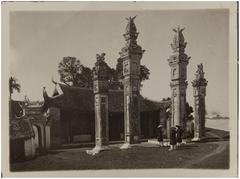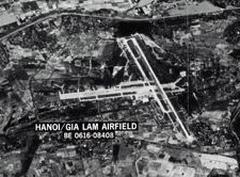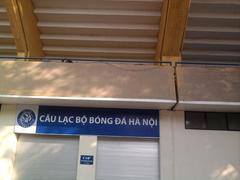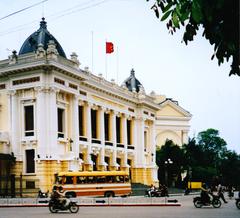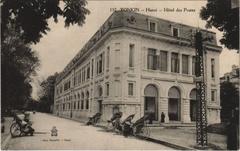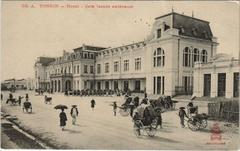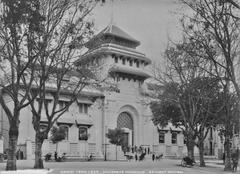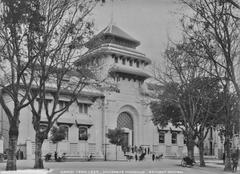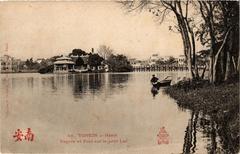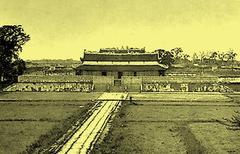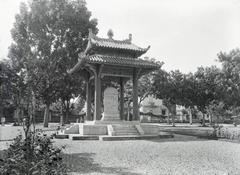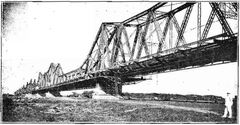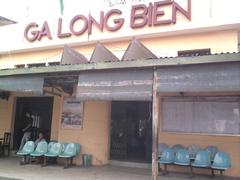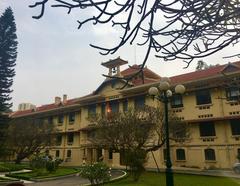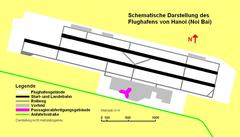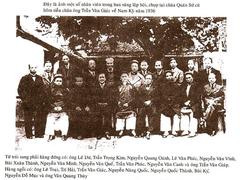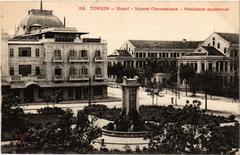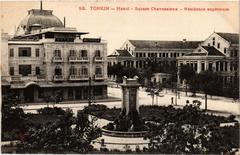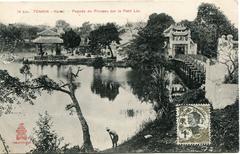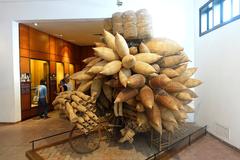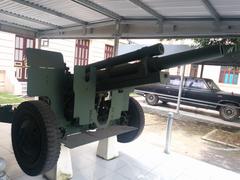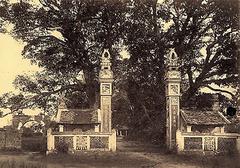Gia Lâm Railway Station Hanoi: Visiting Hours, Tickets, and Travel Guide
Date: 14/06/2025
Introduction
Gia Lâm Railway Station, located in the northeastern Long Biên District of Hanoi, serves as a critical gateway connecting Vietnam’s capital with the country’s northern provinces and China. Established during the French colonial era, the station’s strategic placement near the Red River was intended to facilitate both the transport of goods and passenger travel, supplementing the city-center Hanoi Railway Station (Ga Hà Nội). Over time, Gia Lâm has played various roles—from a colonial logistics hub to a resilient wartime outpost, and now as a modern international rail terminus (Hanoi Guides, Vietnam Railways, Train Spread).
Today, Gia Lâm Railway Station stands out for its direct international rail connections, especially the Hanoi–Nanning route to China. Its customs and immigration facilities, accessible amenities, and proximity to landmarks like Long Biên Bridge and Hanoi’s Old Quarter make it a significant hub for both commuters and international travelers. Recent upgrades and future integration into Hanoi’s urban rail system underscore its growing importance in Vietnam’s transportation landscape.
This comprehensive guide provides essential information on visiting hours, ticketing, station facilities, travel tips, and cultural context, ensuring you can plan your journey with confidence.
Table of Contents
- Historical Overview of Gia Lâm Railway Station
- Role in Hanoi’s Rail Network
- Visiting Gia Lâm Railway Station: Hours, Tickets, and Accessibility
- Getting to Gia Lâm Station
- Station Facilities and Amenities
- International Train Connections and Border Procedures
- Safety, Security, and Accessibility
- Recent Developments and Future Prospects
- Nearby Attractions and Cultural Highlights
- Practical Travel Tips
- Frequently Asked Questions (FAQ)
- References and Further Reading
Historical Overview of Gia Lâm Railway Station
Constructed in the late 19th and early 20th centuries as part of the Indochina rail expansion, Gia Lâm Railway Station was designed to support both economic activity and administrative control by connecting Hanoi with northeastern destinations and the Chinese border. Its riverside location allowed for efficient movement of goods, especially coal and agricultural products heading to Hai Phong port for export.
Gia Lâm’s significance deepened during the First Indochina War and the Vietnam War, as its position—just outside the dense city center—made it less vulnerable to bombing. The station became a lifeline for troop movements, emergency evacuations, and the transport of essential supplies. Despite repeated bombings, the facility was swiftly repaired, reflecting its vital role in wartime logistics.
Post-reunification, Gia Lâm underwent modernization to support growing passenger and freight demand, and to facilitate international rail services. Most notably, it became the departure point for trains to China, equipped with customs and immigration services. Architecturally, the station exhibits a utilitarian mid-20th-century style, prioritizing capacity and functionality over ornamentation. Its platforms and waiting halls have been witness to countless personal stories of migration, separation, and reunion.
Role in Hanoi’s Rail Network
Gia Lâm Railway Station serves as a primary terminus for routes heading northeast towards Lang Son and the Chinese border, as well as east to Hai Phong and Ha Long Bay. Unlike the central Ga Hà Nội, which focuses on north-south routes, Gia Lâm specializes in services that avoid the congested city core, making it particularly valuable for international and regional travel (Hanoi Guides).
In addition to passenger services, Gia Lâm is a crucial node for freight, enabling Hanoi’s role as a commercial hub and supporting the export of Vietnamese goods to China and beyond. The integration of passenger and freight operations at Gia Lâm reflects the station’s multifunctional character within Vietnam’s rail infrastructure.
Visiting Gia Lâm Railway Station: Hours, Tickets, and Accessibility
Visiting Hours
- Station Hours: Open daily from 5:00 AM to 10:00 PM.
- Ticket Counters: Generally operate from 5:00 AM to 9:00 PM, though international train passengers should arrive earlier for customs and immigration procedures.
Ticket Information
- Domestic Tickets: Available at on-site ticket counters during operating hours.
- International Tickets: Sold at Gia Lâm and the main Hanoi Railway Station. Early booking is advised, particularly for the popular Hanoi–Nanning route.
- Online Booking: Use official websites or authorized travel agencies (Train Spread, Vietnam Train, China Highlights).
- Payment Methods: Primarily cash (Vietnamese Dong or US Dollars for international routes). Credit card acceptance is limited.
- Tips: For international routes, have your passport and visa ready when purchasing tickets.
Accessibility
- The station is equipped with ramps, elevators, and dedicated seating for passengers with mobility needs.
- Accessible restrooms and assistance upon request are available. Travelers with disabilities should contact the station in advance to arrange support.
Getting to Gia Lâm Station
- By Taxi/Ride-Hailing: Taxis and apps like Grab provide convenient access. The journey from central Hanoi (e.g., Old Quarter) typically takes 20–30 minutes and costs about 80,000–120,000 VND.
- Public Bus: Several routes (notably 11, 40, 43) connect the city center to Gia Lâm, with fares between 7,000 and 10,000 VND.
- Private Vehicle: Accessible via Ngô Gia Khảm Street, with parking for cars and motorbikes. Parking may be limited during peak periods.
- Cycling: Adventurous visitors can cycle across Long Biên Bridge, enjoying scenic river views. Bicycle parking is available at the station.
Station Facilities and Amenities
- Waiting Areas: Covered seating; arrive early during busy periods.
- Restrooms: Basic but clean; bring personal toiletries.
- Food and Refreshments: Kiosks offer snacks and drinks; nearby eateries serve Vietnamese dishes like pho and banh mi.
- Luggage Services: Short-term storage is available for a fee; keep valuables with you.
- Information Desk: Limited English support; signage in Vietnamese and some English.
- Security: CCTV and uniformed personnel are present throughout the station.
- Connectivity: No public Wi-Fi, but mobile network coverage is strong.
International Train Connections and Border Procedures
Key International Routes
- Nanning – Hanoi: The main international line, with sleeper compartments and customs facilities at Gia Lâm.
- Beijing – Hanoi: Service available with train changes; less frequent.
Border Crossing
- Checkpoints: Pingxiang (China) and Dong Dang (Vietnam).
- Procedure: Passengers disembark for exit and entry inspections with luggage.
- Timing: Night-time border checks; exit at Pingxiang around 22:10, entry at Dong Dang around 2:00 AM.
- Required Documents: Passport, Vietnam visa (if applicable), and arrival cards.
Practical Tips
- Prepare for two luggage checks during the journey.
- Bring toilet paper for the Chinese train segment.
- English is not widely spoken; translation apps or phrase cards are helpful.
Safety, Security, and Accessibility
- Security Measures: CCTV surveillance, uniformed guards, and controlled access to platforms.
- Boarding: Valid tickets (and passport/visa for international travel) are required at checkpoints.
- Luggage: Lockable storage is available; keep valuables close.
- Emergency Preparedness: Clearly marked exits and trained staff; first aid and hospital access nearby.
- Public Health: Enhanced cleaning, hand sanitizers, and mask requirements during outbreaks.
Recent Developments and Future Prospects
Gia Lâm Railway Station has seen significant investment in digital ticketing, enhanced security, and multilingual signage. As part of Hanoi’s Capital Region Transport Master Plan 2030–2050, Gia Lâm is expected to integrate with the growing urban rail network, with major infrastructure upgrades, platform modernization, and smart technologies planned by 2045. The station is poised to handle millions of trips daily, supporting both passenger and freight operations and strengthening international connectivity (Vietnam Railways).
Nearby Attractions and Cultural Highlights
- Long Biên Bridge: A historic landmark spanning the Red River, ideal for photos and scenic walks.
- Hanoi Old Quarter: Vibrant streets with colonial architecture, markets, and local cuisine, a short drive from the station.
- Red River Banks: Picturesque views and local life along Hanoi’s major waterway.
Practical Travel Tips
- Arrive early, especially for international departures.
- Keep all travel documents secure and accessible.
- Use official ticket counters or trusted online platforms.
- Pay attention to announcements, primarily in Vietnamese—translation apps are useful.
- Use licensed transportation for station transfers.
Frequently Asked Questions (FAQ)
Q: What are Gia Lâm Railway Station’s opening hours?
A: The station operates daily from 5:00 AM to 10:00 PM.
Q: How can I purchase tickets?
A: Buy at official counters, through authorized agents, or reputable online platforms. International routes require passport and visa.
Q: Is Gia Lâm Station accessible for people with disabilities?
A: Yes, with ramps, elevators, and accessible restrooms. Advance assistance is recommended for complex needs.
Q: How do I reach Gia Lâm Station from the city center?
A: By taxi, Grab, public buses (lines 11, 40, 43), or private vehicle.
Q: Are there food options at or near the station?
A: Yes, with kiosks and local eateries offering Vietnamese meals.
References and Further Reading
- This guide is based on information from Hanoi Guides, Vietnam Railways, Train Spread, and China Highlights.
- For travel maps, see Mapcarta’s Gia Lâm page.
Conclusion
Gia Lâm Railway Station exemplifies Hanoi’s historical depth and modern aspirations, offering travelers efficient services, international connections, and access to local culture. Whether you’re journeying to China, exploring northern Vietnam, or delving into railway heritage, Gia Lâm is a gateway worth discovering. For up-to-date schedules and travel tips, use the Audiala app, check official railway platforms, and explore related articles for deeper insight into Hanoi’s rail network and attractions.


